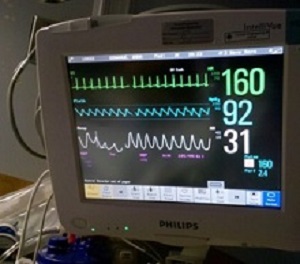 A large study validated the Ottawa Chest Pain Cardiac Monitoring Rule that could safely take a third of chest pain patients in the emergency room off heart monitors, potentially freeing up beds for sicker patients and reducing waiting times.
A large study validated the Ottawa Chest Pain Cardiac Monitoring Rule that could safely take a third of chest pain patients in the emergency room off heart monitors, potentially freeing up beds for sicker patients and reducing waiting times.
"Chest pain is one of the most common reasons people visit Canadian emergency departments, with around 800,000 visits a year," said Dr Venkatesh Thiruganasambandamoorthy, lead author of the study and a scientist and emergency physician at The Ottawa Hospital and an assistant professor at the University of Ottawa.
"Between the two emergency departments at The Ottawa Hospital we see around 35 chest pain patients every day, and usually 25 are assigned to monitored beds. This rule would let us safely remove eight patients from these beds, freeing up the monitors for other patients."
About 70% of chest pain patients who come to the emergency department are put in beds with heart monitors in order to detect a potentially dangerous condition called arrhythmia, or irregular heartbeat. However, previous studies have shown that this condition is rare, with less than two percent of chest pain patients experiencing it during stay.
This is why Ottawa researchers had previously developed a simple, highly sensitive tool to identify those patients who can be safely removed from heart monitors. According to the Ottawa Chest Pain Cardiac Monitoring Rule, patients can be removed if they have no current chest pain and there are no significant abnormalities in the electrocardiogram reading.
Patients are normally taken off the monitor after about eight hours, when they are discharged home. Applying this rule will allow patients to be taken off monitors much sooner. If implemented when they first arrive, the rule will allow them to be redirected to a non-monitored area of the emergency department.
To verify the rule, researchers observed chest pain patients in the emergency department. Then they tested whether the tool could accurately predict which patients had needed to stay on heart monitors because of irregular heartbeat.
They found that 15 of the 1,125 patients admitted to The Ottawa Hospital emergency departments for chest pain between November 2013 and April 2015 experienced irregular heartbeat during their eight-hour stay. The rule was able to predict with 100% accuracy the 15 patients who needed to stay on heart monitors. It also indicated that 36% of the 796 patients who were monitored during the study could have been safely removed from the monitors.
"This rule now has the potential to take a large number of low risk chest pain patients off of heart monitors," said Thiruganasambandamoorthy. "We started using this rule in The Ottawa Hospital emergency departments a few months ago, and we're watching the outcomes very closely. We have also spoken to several emergency departments across the country who are excited about bringing this rule into their hospitals."
Abstract
Background: Most patients with chest pain in the emergency department are assigned to cardiac monitoring for several hours, blocking access for patients in greater need. We sought to validate a previously derived decision rule for safe removal of patients from cardiac monitoring after initial evaluation in the emergency department.
Methods: We prospectively enrolled adults (age ≥ 18 yr) who presented with chest pain and were assigned to cardiac monitoring at 2 academic emergency departments over 18 months. We collected standardized baseline characteristics, findings from clinical evaluations and predictors for the Ottawa Chest Pain Cardiac Monitoring Rule: whether the patient is currently free of chest pain, and whether the electrocardiogram is normal or shows only nonspecific changes. The outcome was an arrhythmia requiring intervention in the emergency department or within 8 hours of presentation to the emergency department. We calculated diagnostic characteristics for the clinical prediction rule.
Results: We included 796 patients (mean age 63.8 yr, 55.8% male, 8.9% admitted to hospital). Fifteen patients (1.9%) had an arrhythmia, and the rule performed with the following characteristics: sensitivity 100% (95% confidence interval [CI] 78.2%–100%) and specificity 36.4% (95% CI 33.0%–39.6%). Application of the Ottawa Chest Pain Cardiac Monitoring Rule would have allowed 284 out of 796 patients (35.7%) to be safely removed from cardiac monitoring.
Interpretation: We successfully validated the decision rule for safe removal of a large subset of patients with chest pain from cardiac monitoring after initial evaluation in the emergency department. Implementation of this simple yet highly sensitive rule will allow for improved use of health care resources.
Authors
Shahbaz Syed, Mathieu Gatien, Jeffrey J Perry MD, Hina Chaudry, Soo-Min Kim, Kenneth Kwong, Muhammad Mukarram, Venkatesh Thiruganasambandamoorthy
[link url="http://www.ohri.ca/newsroom/newsstory.asp?ID=881"]Ottawa Research Institute material[/link]
[link url="http://www.cmaj.ca/content/189/4/E139"]Canadian Medical Association Journal abstract[/link]
